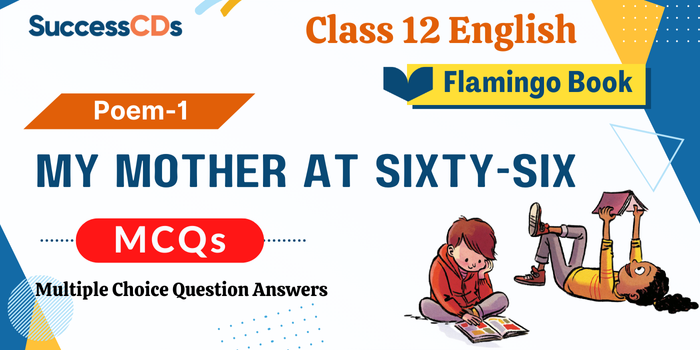
“My Mother at Sixty Six” MCQs with Answers from CBSE Class 12 English Flamingo Book Poem 1
My Mother at Sixty Six MCQs of Class 12 English Poem 1, My Mother at Sixty Six by Kamala Das have been compiled for students to practice. Students of Class 12 can prepare the MCQs of Poem 1, My Mother at Sixty Six from NCERT Flamingo book. Each question has four options followed by the correct answer. Students can also take a free test of the MCQs of My Mother at Sixty Six. These MCQ Questions have been selected based on the latest exam pattern as announced by CBSE.
For Correct Answers, see end of post. (below)
Related:
- My Mother at sixty-six Important Question Answers
- My Mother at sixty-six Summary, Explanation Word Meanings
- Character Sketch of the Poet and her mother | My Mother at Sixty-six
- My Mother at Sixty Six Previous Years Question with Answers
Class 12 English Flamingo My Mother at Sixty Six Poem 1 Multiple Choice Questions
Multiple Choice Questions (MCQs) are a type of objective assessment in which a person is asked to choose one or more correct answers from a list of available options. An MCQ presents a question along with several possible answers.
1- Who is the poet of this poem?
A) John Keats
B) Rudyard Kipling
C) William Wordsworth
D) Kamala Das
2- Why was the poet going to Cochin?
A) for work
B) for studies
C) to take a flight
D) for vacation
3- What is the kind of pain and ache that the poet feels?
A) Losing her mother
B) heart attack
C) headache
D) children screaming at her
4- In which languages has Kamla Das written stories and novels?
A) English and Tamil
B) English and Hindi
C) English and Urdu
D) English and Malayalam
5- Name the poetic devices used in the poem.
A) metaphor
B) similie
C) alliteration
D) all of these
6- Why did the poet hide her fear from her mother?
A) She was afraid that the mother would not be able to bear the pain
B) She feared being scolded by the mother
C) She was not so close to her mother to share her deep emotions
D) All of these
7- Which poetic device is used in “Trees sprinting” ?
A) metaphor
B) simile
C) alliteration
D) Personification
8- What is the distinctive feature of the poem?
A) its metaphors
B) simile used
C) alliteration used
D) narrative style using a single sentence in a set of 14 lines
9- Why has the poet brought the image of trees and children?
A) she loved nature
B) her mother was boring
C) she wanted to escape the stress
D) to draw a contrast
10- What is the main idea of the poem?
A) Old age
B) discolouration of skin
C) carelessness of a daughter
D) lack of strength
11- What did the poet realize with pain?
A) her mother’s appearance like a corpse
B) her mother does not love her
C) she did not receive care from her parents
D) she has duties towards her husband
12- What is the familiar ache?
A) her childhood fear of losing her mother
B) her mother’s weak health
C) her duties
D) her helplessness
13- The word “Amma” means-
A) beloved
B) friend
C) mother
D) guide
14- Winter’s moon’ is a reference to the mother’s
A) old age
B) beauty
C) wealth
D) young age
15- What does ‘ashen face’ signify?
A) burned face
B) face is covered with ash
C) Pale and lifeless face of poet’s mother
D) face is scarred
16- What does the poet notice outside the car?
A) sprinting trees and running children
B) schools and roads
C) other vehicles
D) many people on the road
17- What do the parting words “See you soon Amma” signify?
A) her carelessness
B) Her optimistic farewell full of cheerfulness
C) she bids goodbye like this
D) she is in a hurry
18- What does the poet’s smile signify in the poem?
A) Her assurance to mother and helplessness inside
B) she has a responsibility
C) she is happy
D) she is a loving daughter
19- At the security check, why was the mother standing at a distance?
A) only poet was travelling
B) mother had a separate que of senior citizens
C) the poet did not want to take mother along
D) mother was unwell and was not allowed to board the flight
20- What worried the poet when she looked at her mother?
A) her face
B) her broken arm
C) her loving words
D) her declining age
21- What can be said about the number of children spilling out of the homes?
A) They were only 2 children
B) They were in huge number
C) Nothing can be said
D) All of these
22- Why has the poet used the imagery of merry children spilling out of their homes?
A) to show hope
B) to show happiness
C) to show noisy kids
D) to show energy and liveliness
23- Which rhyming scheme is used in the poem?
A) coupled rhyme
B) monorhyme
C) Alternate rhyme
D) free verse
24- Quote an example of a simile used in the poem.
A) familiar ache
B) like that of a corpse
C) wan and pale
D) the merry children
25- Quote an example of a metaphor used in the poem.
A) as a late winter’s moon
B) she was as old as she looked
C) Driving from my parent’s home
D) her face ashen
26- Quote an example of alliteration used in the poem.
A) like ashen
B) wan, pale
C) Friday morning
D) None of these
27- Quote an example of personification used in the poem.
A) sprinting trees
B) home to cochin
C) airport’s security check
D) All of these
28- Why does the poet feel scared?
A) Because of her duties and commitments
B) Because of her job
C) Bcause of her children
D) Because of her mother’s deteriorating health
29- What is happening in the poem?
A) the poet is leaving her parents’ home and going abroad for higher studies
B) the poet is leaving her parents’ home and going on a vacation
C) the poet is leaving her parents’ home and going to husband
D) None of these
30- What is the tone of the poem towards the end?
A) sad
B) hopeless
C) cheerful
D) resignation with acceptance
31- What does the narrative single sentence style of the poem highlight?
A) Poet’s feelings
B) Poet’s insecurities
C) poet’s confused state
D) poet’s intertwining thoughts
32- How many characters are there in the poem?
A) 1
B) 2
C) 3
D) 4
33- What question arises from the complexity of the situation in the poem?
A) what to do in old age when one cannot take care of oneself and the kids leave
B) how to take care of one’s skin and not look pale and ashen
C) how to drive along with an aging mother
D) How to strike a balance between duties and responsibilities
34- How is the imagery of ‘young trees and merry children’ a contrast to the mother?
A) mother is still while the trees are sprinting and children are spilling
B) mother is burnt like ash while the trees are green and children are happy
C) they are opposites, like spring and autumn season
D) Mother’s health- shows hopelessness while the trees and merry children indicate youthfulness and hope
35- Which of the following is NOT an instance of use of a figure of speech?
A) I saw my mother beside me
B) her face ashen
C) the airport’s security check
D) smile and smile and smile
36- What was the expression of the poet’s face while parting from her mother?
A) satirical
B) funny
C) sad
D) smiling
37- Whose house the poet was leaving?
A) her friend’s house
B) in-law’s house
C) her husband’s house
D) her parents’ house
38- What was the poet’s childhood fear?
A) Parting from her husband
B) Parting from her friends
C) Parting from her siblings
D) losing her mother
39- What were the words she used while parting from her mother?
A) See you soon Ba
B) See you soon beeji
C) See you soon mata ji
D) See you soon, amma
40- What pangs did she feel when she looked at her mother?
A) Pangs of headache
B) Pangs of stomachache
C) Pangs of knee pain
D) Pangs of heartache
41- The childhood fear was the fear of
A) separation from mother
B) exams
C) medical check-up
D) dental treatment
42- She was going to-
A) Goa
B) Mumbai
C) Cochin
D) Not mentioned
43- The poet was driving towards the
A) railway station
B) bus-stand
C) airport
D) metro station
44- The person in the car, beside the poetess, was,
A) her aunt
B) her niece
C) her uncle
D) her mother
45- The mother of the poetess was
A) smiling
B) laughing
C) crying
D) dozing off
46- The poetess says her mother looked pale like a
A) corpse
B) ghost
C) malnourished child
D) anemic person
47- Kamala Das realized that her mother was very
A) young
B) energetic
C) old
D) ill
48- She soon put that thought out of her mind and
A) smiled
B) laughed heartily
C) cried bitterly
D) looked out of the window
49- The narrator also saw children running out of
A) their homes
B) schools
C) parks
D) football ground
50- ‘Children spilling out’ is
A) simile
B) metaphor
C) personification
D) transferred epithet
Click here to take a free test of MCQs of Class 12 My Mother at sixty six from Flamingo book.
ANSWER KEY
| 1 | D | 26 | D |
| 2 | C | 27 | A |
| 3 | A | 28 | D |
| 4 | D | 29 | C |
| 5 | D | 30 | D |
| 6 | A | 31 | D |
| 7 | D | 32 | B |
| 8 | D | 33 | D |
| 9 | D | 34 | D |
| 10 | A | 35 | C |
| 11 | A | 36 | D |
| 12 | A | 37 | D |
| 13 | C | 38 | D |
| 14 | A | 39 | D |
| 15 | C | 40 | D |
| 16 | A | 41 | A |
| 17 | B | 42 | D |
| 18 | A | 43 | C |
| 19 | A | 44 | D |
| 20 | D | 45 | D |
| 21 | B | 46 | A |
| 22 | D | 47 | C |
| 23 | D | 48 | D |
| 24 | B | 49 | A |
| 25 | D | 50 | B |
Class 12 Important Videos Links
| Class 12 English Important Questions Videos |
| Class 12 English Flamingo and Vistas book MCQs Videos |
| Class 12 Flamingo Book Chapter wise Video Explanation |
Class 12 English Poem MCQs
- My mother at sixty six MCQs with Answers NCERT Class 12 English Poem 1
- Keeping Quiet MCQs with Answers NCERT Class 12 English Poem 2
- A Thing of Beauty MCQs with Answers NCERT Class 12 English Poem 3
- A Roadside Stand MCQ with Answers NCERT Class 12 English Poem 4
- Aunt Jennifer’s Tigers MCQ with Answers NCERT Class 12 English Poem 5
Also See:
- CBSE Class 12 English Notes, Lesson Explanation
- CBSE Class 12 English MCQ Question Answers
- Class 12 English Flamingo Book Chapter wise word meaning
- Class 12 English Flamingo Poems Word meaning
- Class 12 English Vistas Book Word meanings
- CBSE Class 12 English Important Question Answers
- Character Sketch of Class 12 English
- Class 12 English Core Previous Year Question Answers (2019-2024) Chapterwise
- Class 12 English Core Previous Year Question Paper with Solutions 2019-2024


